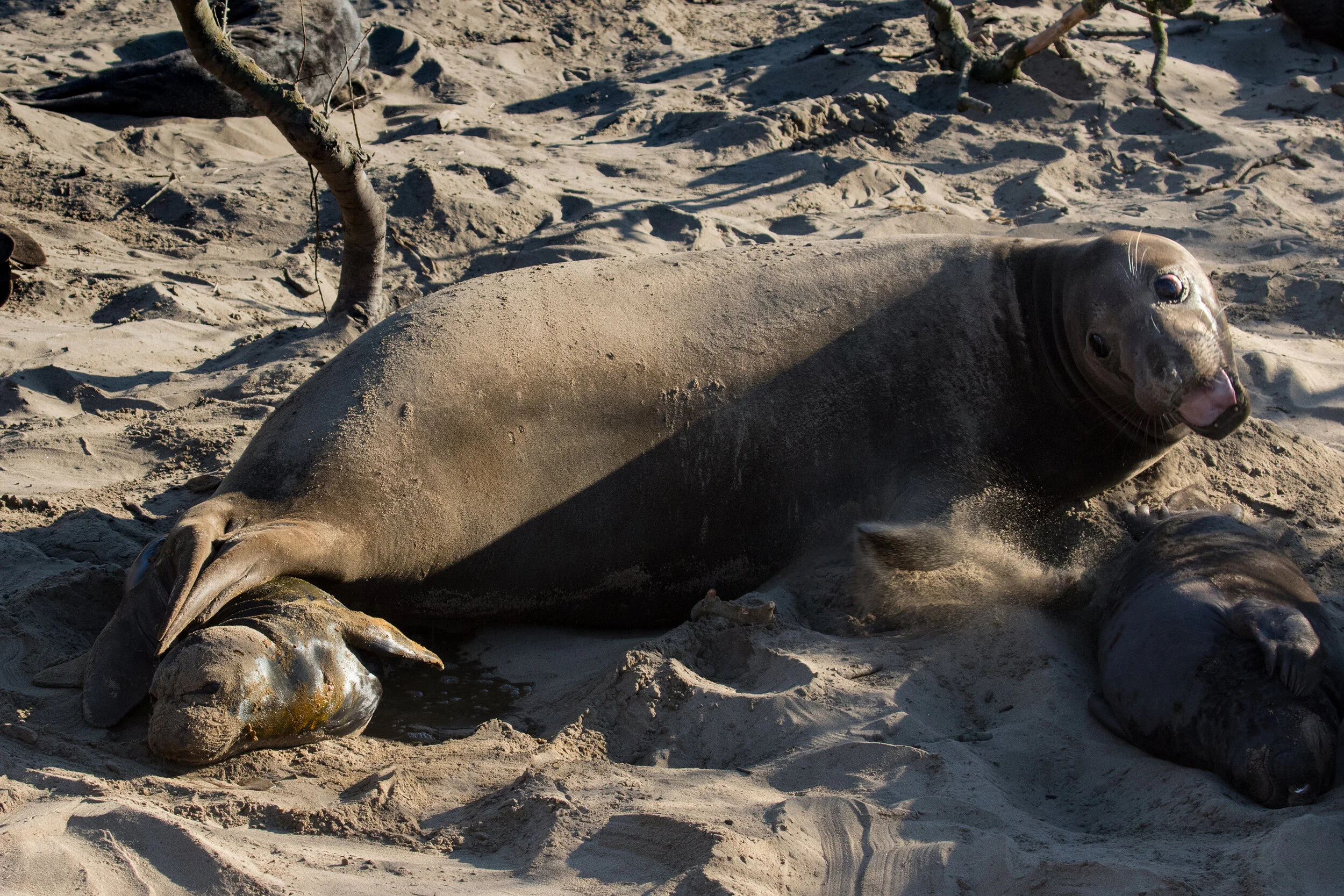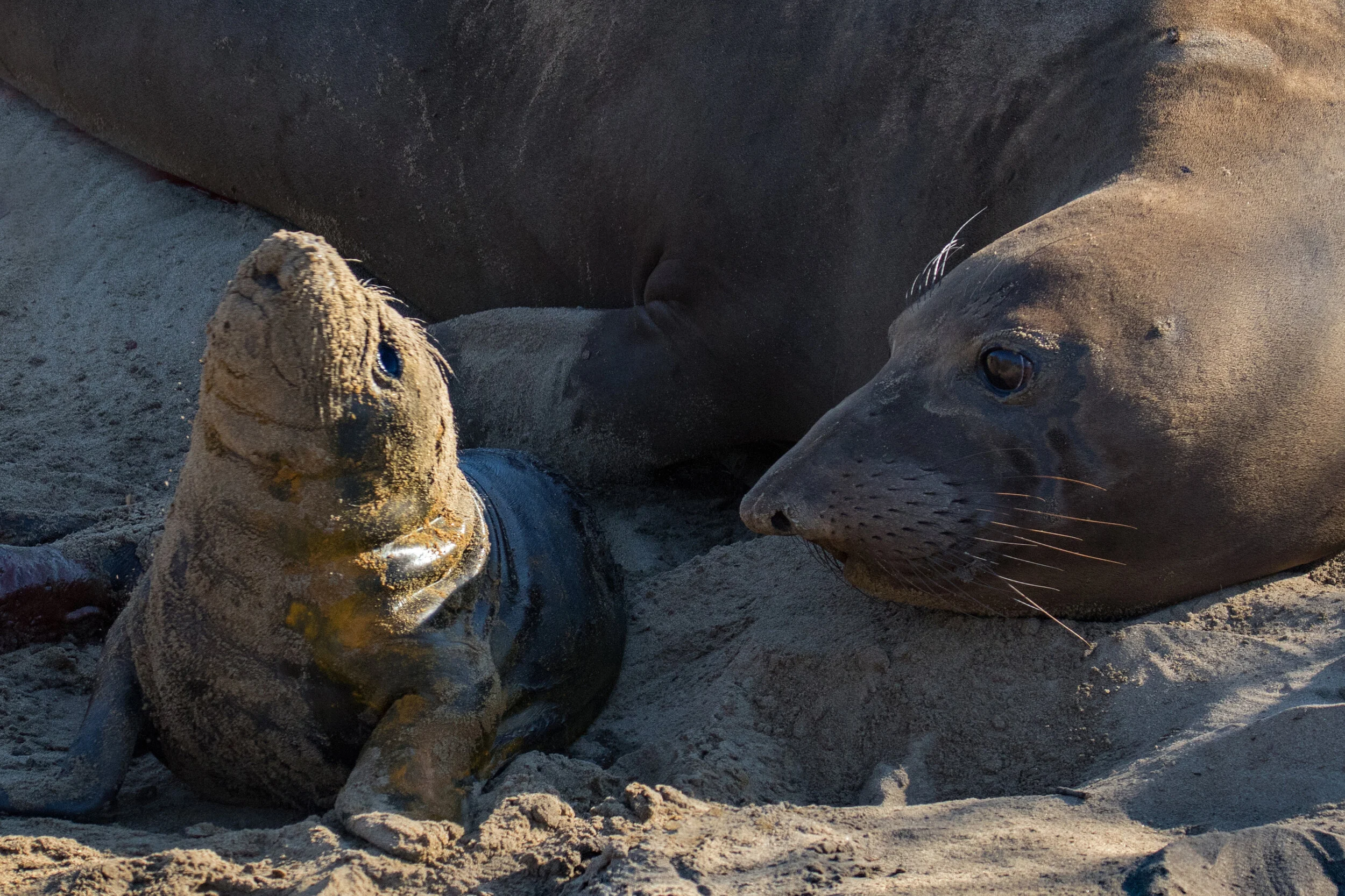An elephant seal enters the world: Capturing a rare and beautiful moment in words and on camera
By Jodi Frediani, Wildlife Photographer
The late afternoon winter sky was clear, the sun low, and the air brisk as I hiked from the Visitor’s Center at Ano Nuevo State Park with my cousin Pam Koch. Pam is a docent who leads guided tours of the elephant seal rookery located on the mainland beaches sheltered by Ano Nuevo Island, a mere forty miles south of San Francisco Bay.
This Saturday afternoon visit was special, as Pam had gifted me a spot at the Ano Nuevo Seal Adventure, the annual fundraiser sponsored by the Coastside State Parks Association. Rather than be led from one viewing location to another, guests could wander through the dunes to the best viewing spots, directed by rangers and docents stationed at trail intersections. We were cautioned to avoid errant resting males who might be found smack in the middle of the trails, looking like enormous, misplaced boulders. Unsuspecting visitors could easily startle these sleeping behemoths who can move their blubbery selves surprisingly fast with the right motivation.
Seal Adventure is a golden opportunity for photographers, as we were allowed to spend as much time as we wished observing from an assortment of stations safely located along the dunes. Below us the beaches were chock-a-block full of the fat bodies of resting elephants seals who had begun arriving in December.
It was easy, too easy, to get distracted by the mass of blubbery bodies spread from the dunes to the water’s edge. Flipping sand to cool themselves in the warm January sun, young males and females enjoyed a well-deserved rest after spending months at sea. Here and there, a pup could be seen snuggling close to its mother, and the enormous adult bulls, with their elephant trunk-like proboscises leading to the name ‘elephant seal’, were scattered among the smaller animals.
Elephant seals on beach. Photo: Jodi Frediani
Pairs of large bulls could be seen in the shallow surf, or at the edge of the crowd, fighting to become the alpha and garner or maintain a harem of females. The soothing sound of the surf on the beach was punctuated by the sonorous racket of their snorting and grunting.
These battles sometimes become bloody, leaving the bulls bearing scars on their ‘chest shields,’ though most of the displays are more a matter of intimidation. Nonetheless, these face-offs are important, as only the few high-ranking males actually get to mate.
But it was the female closest to us that suddenly caught our attention. Perhaps someone had noticed as she quietly labored, but as her pup emerged into a world of sunshine and sand, exclamations escaped the human crowd, and all faces turned in awe to witness this lucky event. Slithering silently onto the beach, exiting from beneath mom’s rear flippers, a new member of the colony appeared before our very eyes.
Elephant seal birth. Photo: Jodi Frediani
I pointed my camera and clicked away. The pup had instantly exchanged its warm, wet in-utero experience of the past 7+ months for the harsh reality of a face full of sand. Welcome little one! Witnessing a birth is always a magical experience. As a lay midwife, I saw my share of human babies enter the world, providing a helping hand as needed. And as an organic farmer, I watched newborn goats splat onto the straw-covered flooring in their mother’s stalls. Within minutes of shaking off the sticky sac that had been their envelope before birth, they found their wobbly legs.
Photo: Jodi Frediani
Photo: Jodi Frediani
But a wild animal? Viewing a wild birth is a rare event. No one has ever seen a humpback whale get born. Bears give birth hidden away in dens, as do foxes and wolves. Most mammals choose secrecy for bringing their young into the world. Predators abound and the scent of birth could be a dangerous attractant.
Even elephant seals are known to mostly give birth at night. Learning this made our good fortune all that more special. Whether it’s simply security in numbers or the decline of predators such as mountain lions and wolves in our environment, elephant seals give birth on land out in the open. Pups are more likely to get squashed by a large bull or separated from their moms and die of starvation than they are to be snatched by a mountain lion. Pups born in the ocean could become prey to killer whales or great white sharks, which manage to snag some weaned pups as they leave the rookery.
Mom quickly turned to greet her pup, sniffing and calling, establishing an important bond to enable both to keep track of each other on the crowded beach. But that relationship would be short lived. Females arrive just days before giving birth, then stay with their pups for a brief 28 days before mating, then heading back out to sea. During those first four weeks, the pup must fatten up, quadrupling in size, drinking large quantities of the richest milk in the mammal world (55% fat), while mom subsists off her own blubber.
Once the pup is weaned, it must fend for itself, learning how to swim and stay out of the way of those enormous bulls. Within six short weeks of birth, this weaner, as it will be called, will set out to sea, heading northwest, as its mother did before it. Now the task will be to learn to catch fish and other prey such as squid, eels and small sharks, and navigate the wide Pacific Ocean where it will spend 80% of its life. As the seal matures, it will learn to dive 1550 meters beneath the ocean’s surface, and hold its breath for 20-60 minutes depending on whether it is a female or male.
The biggest threat elephant seals have had to face has been extensive hunting by humans over a 40-50 year period starting in the early 1800s, when over 250,000 seals were killed. Their thick blubber lead to their demise as it made excellent lamp oil. By 1910, there were believed to be just 100 elephant seals left in the eastern Pacific, all found off Baja California, Mexico. But the population has rebounded. These seals are now protected under the Marine Mammal Protection Act of 1972. Still today, as populations continue to increase in number and range, competition for food from over-fishing, impacts from climate change, and lack of genetic diversity from the drastic population declines may prove another difficult challenge to overcome.
But here, just a stone’s throw away, was another reminder of their success story. Our little pup had dried and was now snuggled close to mom. And an hour and a half after the pup had made its grand entry I was shepherded away by the last of the docents and their friends. Pam had had to leave some time earlier. I said farewell to the little pup, wished it well and counted my blessings, as the last of the sun’s rays shed a golden light across the beach and the fat bodies of hundreds of elephant seals temporarily inhabiting the shoreline.
Photo: Jodi Frediani
Photo: Jodi Frediani






